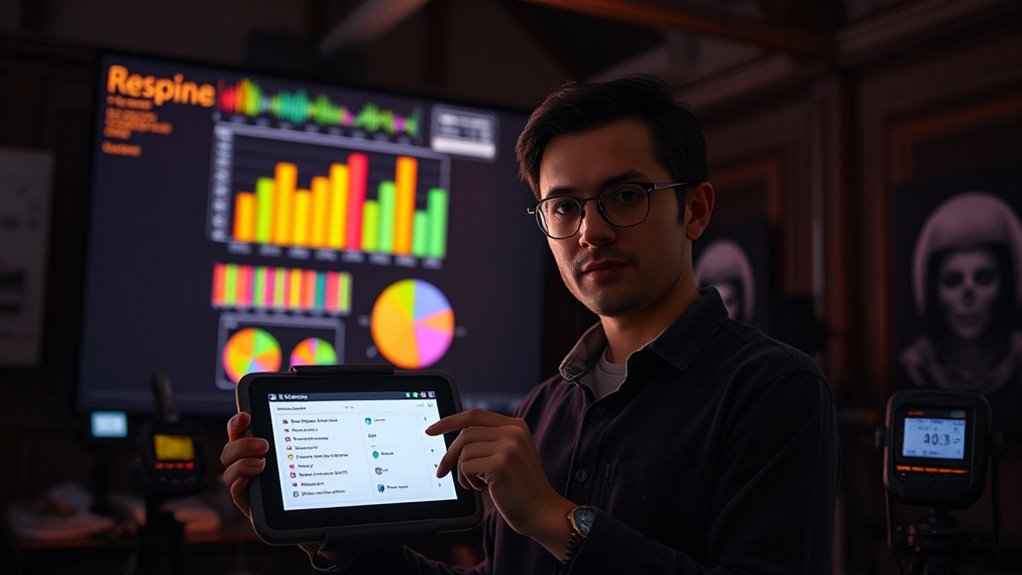To create effective polls and surveys for paranormal research, focus on clear questions about common phenomena like apparitions or sounds, and target relevant locations or events. Use diverse question formats such as multiple-choice and open-ended prompts to gather detailed insights. Share your surveys on platforms community members frequent, ensuring confidentiality and ethical data handling. Analyzing responses reveals patterns, hotspots, and timeframes, helping you refine investigation efforts—continue exploring to discover how to optimize your research tools further.
Key Takeaways
- Identify specific paranormal phenomena and locations to target relevant survey questions and gather meaningful data.
- Use clear, unbiased, and focused questions with a mix of closed and open-ended formats to capture comprehensive insights.
- Distribute surveys across niche online platforms, social media, and community forums to reach engaged paranormal enthusiasts.
- Incorporate ethical practices by ensuring participant confidentiality, informed consent, and secure data handling.
- Analyze collected data for patterns and hotspots to refine research focus and develop targeted investigation strategies.
Identifying Key Topics for Paranormal Inquiry

To effectively shape paranormal research, you need to pinpoint the key topics that matter most. Start by considering the most common phenomena reported, like apparitions, unexplained sounds, or physical disturbances. Focus on questions that clarify the context, such as locations with frequent activity or specific events that trigger sightings. Think about what evidence you need—photos, audio recordings, or personal accounts—and determine which topics will yield the most valuable insights. Prioritize issues that have a broad impact or unexplored angles, ensuring your survey captures diverse experiences. By identifying these core areas, you’ll create targeted polls that gather relevant data, helping you understand patterns and better direct your investigative efforts. Incorporating specialized knowledge can further refine your questions and improve data accuracy. Clear focus now simplifies analysis and enhances future research.
Designing Effective and Engaging Questions

Crafting questions that are both clear and engaging is essential for collecting meaningful data in paranormal research. You want your questions to be straightforward, avoiding jargon or ambiguous wording that could confuse respondents. Use simple language and keep questions focused on one idea at a time to ensure clarity. Incorporate open-ended prompts when you want detailed insights, but also include closed questions for quick, quantifiable data. To boost engagement, frame questions in a way that sparks curiosity or personal relevance, encouraging honest responses. Avoid leading or biased language that might influence answers. Test your questions beforehand to identify any confusing parts. Well-designed questions will help you gather reliable data, bringing your paranormal research closer to uncovering valuable insights. Additionally, understanding Gold IRA options can provide financial stability for researchers planning long-term projects.
Choosing the Right Platforms for Distribution

Choosing the right platforms for distribution is essential to reaching the audiences most interested in paranormal research. You need to identify where your target community spends their time online. Social media platforms like Facebook, Reddit, and Twitter are great for engaging enthusiasts and collectors of paranormal content. Niche forums or dedicated paranormal websites can also help you connect with dedicated researchers and hobbyists. Consider email newsletters if you want to reach subscribers already interested in your work. Additionally, sharing your surveys through relevant groups or pages ensures your questions reach people with genuine curiosity about the paranormal. By selecting the platforms your audience uses most, you increase participation and gather more meaningful insights for your research efforts. Using cookies and data tracking techniques can also help you analyze which platforms yield the best engagement and refine your distribution strategy accordingly.
Utilizing Multiple Question Formats for Rich Data

Using multiple question formats in your surveys can considerably enrich the data you collect. Combining different types of questions allows you to gather detailed insights and understand respondent perspectives more effectively. For example, use multiple-choice questions for quantitative data, and open-ended questions for qualitative insights. Including Likert scales helps measure the intensity of beliefs or experiences, while ranking questions reveal priorities. To visualize this, consider the table below:
| Question Type | Purpose |
|---|---|
| Multiple-choice | Quantitative responses |
| Open-ended | In-depth personal insights |
| Likert scale | Measure agreement or intensity |
| Ranking | Prioritize or order responses |
Mixing formats keeps your survey engaging and captures diverse data, making your paranormal research more thorough. Incorporating question formats tailored to your research goals can enhance the clarity and reliability of your findings.
Ensuring Anonymity and Ethical Considerations

You need to protect your participants’ identities to guarantee their privacy and build trust. Making sure you obtain informed consent clarifies their rights and the purpose of your survey. By addressing these ethical considerations, you create a responsible research environment that respects everyone involved. Including proper data handling practices further safeguards participant confidentiality and enhances the credibility of your findings.
Protecting Participant Identities
Protecting participant identities is essential to maintaining ethical standards in paranormal research surveys. You should clearly communicate how you’ll safeguard their personal information and ensure confidentiality. Use anonymized data collection methods, like removing identifiable details before analysis, to prevent anyone from tracing responses back to individuals. Store data securely, employing password protection and encryption, and restrict access to authorized personnel only. Respect participants’ privacy by avoiding questions that are overly invasive or unnecessary. Always handle sensitive information with care, and be transparent about your data management practices. Incorporating confidentiality protocols helps reinforce trust and demonstrates your commitment to ethical research practices. By prioritizing confidentiality, you foster trust and encourage honest participation, which ultimately enhances the quality and integrity of your research. Protecting identities isn’t just ethical—it’s essential for credible paranormal studies.
Obtaining Informed Consent
Before participants share their experiences in paranormal research surveys, obtaining informed consent is essential to guarantee ethical standards are met. You need to clearly explain the purpose of your survey, what participation involves, and any potential risks or benefits. Assure participants understand they can withdraw at any time without penalty. Respect their privacy by detailing how their data will be used and stored, emphasizing confidentiality and anonymity. Provide written or verbal consent options, making it easy for participants to ask questions before proceeding. Remember, ethical research isn’t just about compliance; it’s about respecting your participants’ rights and well-being. By securing informed consent, you foster trust and create a foundation for honest, meaningful responses in your paranormal study. Staying informed about legislative changes related to research ethics can further enhance the integrity of your study.
Analyzing Responses to Detect Patterns and Trends

Once responses from polls and surveys are collected, analyzing them carefully can reveal meaningful patterns and trends that might otherwise go unnoticed. Look for recurring themes, common locations, or time periods when phenomena are reported. Quantify responses to identify dominant beliefs or experiences. Use visual tools like charts or tables to spot correlations. For example:
| Pattern Detected | Possible Explanation | Action Step |
|---|---|---|
| Increased sightings during full moon | Lunar influence | Focus future surveys on lunar phases |
| Repeated reports of electronic disturbances | Technological interference | Investigate specific devices or areas |
| Certain locations show higher activity | Hotspots for paranormal events | Conduct targeted investigations |
| Specific time frames show peaks | Temporal factors | Schedule follow-ups accordingly |
This approach helps you interpret data effectively and guides your next research steps. Additionally, understanding paranormal phenomena can enhance your ability to recognize subtle patterns.
Incorporating Feedback to Refine Future Surveys

Incorporating feedback from survey participants is essential for refining your future research efforts. When you review participant comments and suggestions, you gain valuable insights into what worked well and what didn’t. Pay close attention to recurring themes or concerns, as they highlight areas needing improvement. For example, if respondents mention confusing questions or unclear instructions, adjust your wording or format accordingly. Consider adding new questions based on feedback to explore emerging topics or clarify previous ambiguities. Sharing summarized feedback with participants can also boost engagement and trust. By actively listening and making targeted adjustments, you ensure your surveys become more effective, accurate, and relevant. Incorporating proper question design principles can further enhance the clarity and effectiveness of your surveys. Continuous refinement based on feedback ultimately increases the quality and reliability of your paranormal research.
Encouraging Community Participation and Sharing Results

Engaging your community is essential for enriching paranormal research, as active participation brings diverse perspectives and shared experiences. When you encourage others to share their insights and results, you foster a collaborative environment that enhances data quality and depth. To boost participation and transparency, consider these strategies:
- Share survey results openly, showing how community input shapes research directions.
- Host live discussions or webinars to explain findings and gather further feedback.
- Highlight individual contributions, making members feel valued and motivated.
- Create regular updates to keep the community informed and engaged over time.
- Understanding residency requirements can help ensure that your community members qualify to participate, increasing the relevance and reliability of the data collected.
Leveraging Data to Prioritize Research Focus Areas

To effectively advance paranormal research, you need to use the data collected from community surveys and observations to identify the most promising focus areas. Analyze patterns and recurring phenomena reported by participants, highlighting trends that warrant further investigation. Prioritize topics with consistent reports or strong community interest, as these indicate higher likelihood of meaningful discoveries. Use statistical tools to assess the credibility and significance of the data, filtering out anecdotal or isolated accounts. Collaborate with experts to interpret findings and refine research questions. By systematically leveraging this data, you guarantee your efforts target areas with the greatest potential, saving resources and increasing the chances of meaningful breakthroughs. This approach helps create a focused, evidence-based research roadmap driven directly by community insights.
Frequently Asked Questions
How Can I Ensure My Survey Reaches Diverse Paranormal Communities Effectively?
You can guarantee your survey reaches diverse paranormal communities by sharing it on various social media platforms, forums, and niche groups. Engage with community leaders or influencers to boost visibility. Use inclusive language and offer multiple language options to appeal to a wider audience. Additionally, promote your survey through newsletters, paranormal events, and local meetups. By actively connecting with different groups, you increase your chances of gathering diverse and valuable insights.
What Are Common Pitfalls to Avoid in Paranormal Survey Design?
You should avoid leading questions that bias responses, as they skew your data. Steer clear of overly complex or technical language that can confuse participants. Don’t neglect to pilot your survey first, which helps identify ambiguous questions. Also, guarantee your questions are balanced and inclusive, avoiding assumptions that limit diverse perspectives. Finally, don’t forget to keep your survey concise; lengthy surveys can cause fatigue and reduce completion rates.
How Do I Interpret Ambiguous or Contradictory Survey Responses?
Like steering through a foggy night, interpreting ambiguous or contradictory responses requires patience and careful analysis. You should look for patterns, cross-reference similar answers, and consider the respondent’s context or possible biases. Asking follow-up questions can clarify confusion. Remember, sometimes responses reflect personal perceptions or uncertainties, so stay open-minded. By dissecting inconsistencies thoughtfully, you’ll uncover insights that guide your research with clarity amidst the uncertainties.
What Legal Considerations Should I Keep in Mind When Collecting Paranormal Data?
When collecting paranormal data, you should confirm you comply with privacy laws and obtain informed consent from participants. Clearly explain how their data will be used, stored, and protected. Be aware of any local regulations regarding data collection, especially if recording personal information. Always respect participants’ confidentiality and avoid gathering sensitive data without proper authorization. By following these legal considerations, you protect yourself and build trust with your participants.
How Can I Incentivize Participation Without Biasing Results?
You can incentivize participation by offering small, appealing rewards like gift cards or access to exclusive content, which encourage engagement without influencing responses. Make it clear that honest answers are valued and guarantee your questions are neutral to avoid bias. Keep incentives simple and transparent, so participants feel motivated yet remain unbiased. This approach helps gather genuine data while boosting participation rates effectively.
Conclusion
By creating thoughtful polls and surveys, you can uncover hidden patterns in paranormal experiences. Imagine launching a survey that reveals a surprising link between certain locations and ghost sightings, guiding your next investigation. When you actively listen to community feedback and analyze responses, you empower your research and foster trust. Keep refining your approach, share results openly, and watch your understanding of the paranormal deepen—one question at a time.









